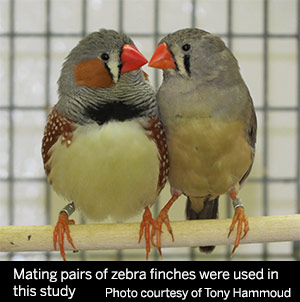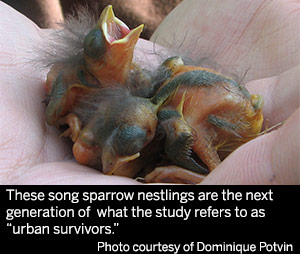Urban Noise: The Not-So-Silent Danger to Songbirds
Could human noise be hurting songbirds? We know our consumption habits are changing the climate, and we’re seeing the results in drought and higher food prices. But it looks like our noise is triggering change, too, though we don’t know exactly how.
For decades, researchers have noticed that some songbird populations weren’t reproducing as well in noisy urban areas as they did in quieter places. And because different birds have many roles in the environment – keeping pest levels in check, carrying pollen, distributing seeds, etc. – their numbers and diversity are a serious concern.
 When it comes to urbanization, there are three general groups of birds. “Urban exploiters” – house sparrows or starlings, for example – may do relatively well in noisy places. “Urban avoiders” such as many warblers don’t have great success or may avoid urban areas. “Urban survivors” are somewhere between exploiters and avoiders, but their success drops off rapidly in noisier spots. Examples of urban survivors include songbirds like finches, orioles and sparrows.
When it comes to urbanization, there are three general groups of birds. “Urban exploiters” – house sparrows or starlings, for example – may do relatively well in noisy places. “Urban avoiders” such as many warblers don’t have great success or may avoid urban areas. “Urban survivors” are somewhere between exploiters and avoiders, but their success drops off rapidly in noisier spots. Examples of urban survivors include songbirds like finches, orioles and sparrows.
Over time, there were theories that road noise, etc., was masking birdsong and disrupting birds’ ability to communicate about food, mates and danger. But what about the successful breeders? What made them different?
Dr. Scott MacDougall-Shackleton and Dr. Dominique Potvin are the Western University researchers behind a study of birds and noise, and MacDougall-Shackleton is the director of the Advanced Facility for Avian Research (AFAR). Their results are intriguing.
The researchers took two groups of domesticated zebra finches and exposed the test group to moderate levels of urban sound. And just as wild birds demonstrated, the tame finches living with the noise had a harder time reproducing. Fewer eggs hatched, and the chicks that did hatch didn’t grow as well.
 So what happened? While the noise didn’t completely block the birds’ from hearing each other, the results suggested that noise was somehow interfering with incubation.
So what happened? While the noise didn’t completely block the birds’ from hearing each other, the results suggested that noise was somehow interfering with incubation.
“It may have hampered communication between the parents,” says MacDougall-Shackleton. “It’s possible that they spent less time in the nest, but I would like to see experiments that directly measure incubation behaviour in noisy and quiet conditions.”
One interesting detail that came out was that most of the successful breeders had higher baseline levels of the avian stress hormone, corticosterone. Both the control group and the test group had some members with high corticosterone, but it didn’t appear to make a difference in the control-group birds – they all had more-or-less the same levels of success. In the noisy group, however, the high-corticosterone birds bred more successfully.
So are some individuals better able to cope with noise?
“Some people don’t do well in high-stress situations, while others thrive in them,” says MacDougall-Shackleton. “The same thing happens in other species, too.”
 But there was another surprise that made the hormonal connection less clear. MacDougall-Shackleton and Potvin’s original hypothesis was that the noise would prove to be a stressor in the birds. But in fact, it didn’t raise corticosterone levels in the test group, which means the birds didn’t experience it as “stressful”.
But there was another surprise that made the hormonal connection less clear. MacDougall-Shackleton and Potvin’s original hypothesis was that the noise would prove to be a stressor in the birds. But in fact, it didn’t raise corticosterone levels in the test group, which means the birds didn’t experience it as “stressful”.
He adds that other lines of research could include chicks’ behavior and levels of their own hormones, but there are many possibilities and much work to be done before the answers are clear.
Dr. Scott MacDougall-Shackleton is the director of Western University’s Advanced Facility for Avian Research (AFAR), a globally unique research facility for the study of avian physiology and behaviour. AFAR is funding by the Canadian Foundation for Innovation (CFI), the Province of Ontario, and matching funds from vendors and Western.

